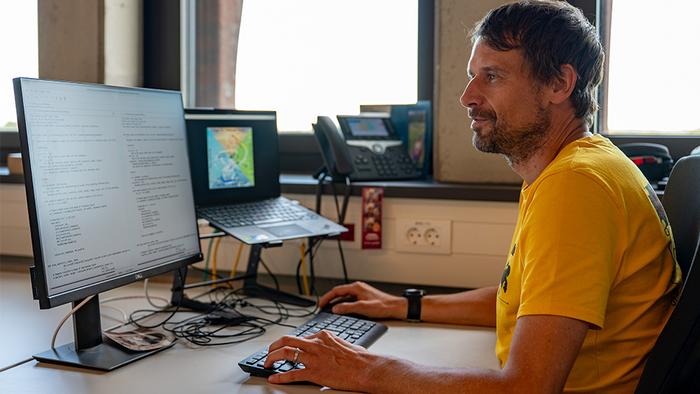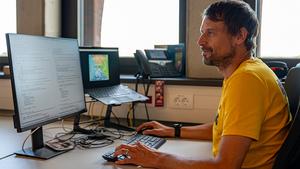
image:
Dominik Hülse, co-author of the study and earth system modeler at the University of Bremen in his office. Together, he and Andy Ridgwell of the University of California refined a computer model of the Earth System to better understand the carbon cycle. Photo: MARUM – Center for Marine Environmental Sciences, University of Bremen, V. Diekamp
Credit: MARUM – Center for Marine Environmental Sciences, University of Bremen, V. Diekamp
Until now, the slow weathering of silicate rocks has been considered as the main factor in climate regulation. In this system, rain takes up carbon dioxide (CO2) from the atmosphere, falls on exposed rocks on land, and slowly dissolves them. When the captured carbon enters the sea together with dissolved calcium from the rocks, it provides the basic material for the construction of mussel shells and limestone reefs, which trap the carbon in the ocean floor for hundreds of millions of years. “When the planet warms, rocks weather faster and absorb more CO2, allowing the Earth to cool down again,” explains Dominik Hülse.
In the past, however, there have also been phases during which the Earth was completely covered by snow and ice. According to the authors, this cannot be explained solely by the slow weathering of silicate rock. Other processes must have been involved during the cooling process.
The missing piece of the puzzle is also linked to carbon storage in the ocean floor. When the CO2 content of the atmosphere increases and the planet warms, more nutrients such as phosphorus make their way into the ocean. The presence of these nutrients stimulates the growth of algae, which take up carbon during photosynthesis. When the algae die, they sink to the sea floor, taking the carbon with them.
In a warmer world with enhanced algae growth, however, the oceans also lose oxygen, which results in the recycling of phosphorus rather than it being stored long-term in the sediments. This creates a feedback loop: the availability of more nutrients in the water results in more algae, whose decomposition in turn consumes more oxygen, causing even more nutrients to be recycled. At the same time, large amounts of carbon are buried in the sediments, which causes the Earth to cool.
For several years Hülse and Ridgwell have been refining a computer model of the Earth System by incorporating more of these processes. “This more complete Earth System model does not always stabilize the climate gradually after a warming phase, rather it can overcompensate and cool the Earth far below its initial temperature — a process that can still take hundreds of thousands of years, however. In the computer model of the study this can trigger an ice age. With the silicate weathering alone, we were unable to simulate such extreme values,” explains Dominik Hülse.
The study shows that lower oxygen concentrations in the atmosphere, which occurred in the geological past, could have triggered stronger nutrient feedbacks, and thus have caused the extreme ice ages of early Earth history.
As humans today add more CO2 into the atmosphere, the planet will continue to warm. But according to the scientists’ model, it could lead again to a cooling overshoot in the long run. However, the next event will likely be milder, because today’s atmosphere contains more oxygen than in the distant past, which dampens the nutrient feedback.
“At the end of the day, does it really matter much if the start of the next ice age is 50, 100, or 200 thousand years into the future?” asks Ridgwell. “We need to focus now on limiting ongoing warming. That the Earth will naturally cool back down is not going to happen fast enough to help us out.”
The study was funded in part by the MARUM-based Cluster of Excellence “The Ocean Floor – Earth’s Uncharted Interface.” In the next step, Hülse wants to use the model to understand why the Earth System has, at times, recovered surprisingly quickly from past climate perturbations, and how interactions with the marine sediments contributed to this.
Participating institutes:
MARUM – Center for Marine Environmental Sciences, and Department of Geosciences, University of Bremen
Department of Earth & Planetary Sciences, University of California (USA)
More information:
MARUM produces fundamental scientific knowledge about the role of the ocean and the seafloor in the total Earth system. The dynamics of the oceans and the seabed significantly impact the entire Earth system through the interaction of geological, physical, biological and chemical processes. These influence both the climate and the global carbon cycle, resulting in the creation of unique biological systems. MARUM is committed to fundamental and unbiased research in the interests of society, the marine environment, and in accordance with the sustainability goals of the United Nations. It publishes its quality-assured scientific data to make it publicly available. MARUM informs the public about new discoveries in the marine environment and provides practical knowledge through its dialogue with society. MARUM cooperation with companies and industrial partners is carried out in accordance with its goal of protecting the marine environment.
Article Title
nstability in the geological regulation of Earth’s Climate.
Article Publication Date
25-Sep-2025
Disclaimer: AAAS and EurekAlert! are not responsible for the accuracy of news releases posted to EurekAlert! by contributing institutions or for the use of any information through the EurekAlert system.

